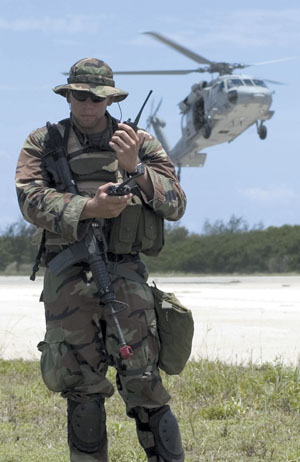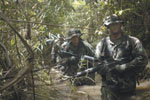Pacific Island Prepares Communications to Withstand Nature's Wrath
 |
| A U.S. Navy petty officer 2nd class communicates on his radio during an exercise in Guam. The island’s Army National Guard has established a new communications network built on the back of a buried Navy fiber optic Sonet ring. |
In what has proved to be a timely and prescient move, the Guam Army National Guard recently upgraded its communication system both to handle expanded mission demands and to be resistant to constant battering by typhoons. The Guard now has an Internet protocol (IP)-based system built around commercial technology and designed to survive storm elements that used to crash the Guard’s old system regularly.
The
The need for better networking on
Capt. Kingbernam L. Bansil, GUARNG, Joint Force Headquarters J-6/ director of information management for the Guam National Guard, explains that the first step toward building a new system was an assessment of the Guam National Guard’s networked installation communications. This assessment revealed a network that comprised a compilation of shortcuts and piecemeal equipment largely serving only to support daily operations. It was a web of bad links and problems that needed fixing, the captain relates. The Guard’s outdated equipment was a result of the different architecture introduced through some reliance on the local telephone system.
Above all, the island faced one requirement little known among other U.S. Army National Guard units. Sitting in the middle of the Pacific Ocean,
Overcoming this problem is more difficult on the Pacific island than it is on the mainland, even in a hurricane-plagued coastal area. Cement on
When this happens, the network is completely severed, Capt. Bansil relates. The command cannot send out data, it cannot communicate with the National Guard Bureau, and mission-essential communications links cannot be assembled. “We are at a complete standstill,” the captain declares.
Repeated catastrophic failures were not the only drawback offered by the old system. The local telephone company also dealt with antiquated equipment. The captain relates that the island’s T1 lines constantly dropped because of exposed pedestals and long response times. And, the Guard’s main circuits had to process through the commercial carrier to reach its long-distance provider.
This effort was complicated by the fact that outside-world missions for the Guam Guard are increasing with the war on terrorism. More military and government civilian organizations are interoperating with the Guard and sharing space and telecommunications needs on
With the help of Capt. Bansil’s counterpart at the National Guard Bureau and engineers sent to
With its broadened mission, the Guard was designated to get new buildings on new land, including a new Guam National Guard Joint Force Headquarters. This provided both opportunities and challenges for building an entirely new communications infrastructure.
As the Guard looked at communications options, it determined that the heart of the new system would be the network providers. The Guard turned to a Cisco engineer who offered an architecture featuring new commercial technology. With this plan in hand, the Guard received approval for a $1.5 million upgrade from the National Guard Bureau’s chief joint information officer.
Bruce Klein, vice president of Cisco’s federal sales organization, explains that his company was an existing installed base vendor for the Guam Guard. With a fiscal infrastructure already in place, the local company team was able to step up and join the upgrade effort.
The new network was designed to provide telecommunications services over IP, including data and voice (VoIP). Video was added when Guam Guard officials saw the advantages of giving their troops the capability of communicating visually with their families over vast distances. Another important use for video over IP is that Guam officials could view commanders’ briefings from
The upgrade was split into two phases over a 90-day period. The first phase involved modernizing the existing local area and wide area networks around a collapsed core as well as implementing a pilot for VoIP. With the success of that pilot, the second phase began. It involved rolling out more of the infrastructure to establish full VoIP over the entire system. Video followed, and the entire upgrade was up and running after just 90 days.
Klein relates that the company’s rich media product known as MeetingPlace enables capabilities such as Web conferencing, voice and videoconferencing. The installation of a double-mesh star topology allowed the Guard to baseline its entire network throughout the organization. The Guard created redundant systems and upgraded its main network capabilities.
The network features a self-healing system that shunts activities from a failed mechanism to a working one. Capt. Bansil notes that the Guard saw an increase in network usage with the network’s telephone systems having better performance and being less expensive than the local telephone system.
 |
| U.S. Air Force airmen wade through the jungles of southern Guam during a joint exercise held in June. Guam is assuming a larger role in joint efforts in the war on terrorism. |
The result has been tremendous increases in efficiency and productivity, Klein maintains. With this infrastructure in place, the Guard can layer new applications atop it. “They are changing the way they communicate with each other, with their own headquarters organizations, with the families of the people serving in
Capt. Bansil declares that the single greatest advantage brought by the new network is its reliability. It has accommodated an expansion from 300 users to more than 1,000, and it has been able to absorb new equipment cost-effectively. Planners can build on a network that already is an open system without needing to upgrade its core.
The network building features double encased walls and a dual power system, including a secondary power generator, inside the building for enhanced survival. When a typhoon hit
“When the National Guard was recalled to assist the island during the recovery period,” he says, “we had a network that we could depend on to send data, voice traffic and video. That enhanced our conferencing needs with the National Guard Bureau, with the police department, with the Department of Homeland Security, with FEMA [the Federal Emergency Management Agency]—these [network] mechanisms helped increase [the network’s] popularity and the demand for a more robust network,” he attests.
Implementing the new system did not entail completely discarding the existing infrastructure. Bob Andersen, Cisco account manager for the Guam Army National Guard, explains that new cable was run where necessary, but the company employed a classic network design complemented by state-of-the-art technologies. The philosophy was to introduce some new technologies into
The network features Cisco 4507 and 3725 routers that have a data traffic throughput of 2 gigabits per second, compared to the original 10 megabits per second in the old system. Its Cisco Catalyst 4500 and 3560 core switches, which are power over Ethernet types, have voice capability. With the collapsed core architecture, the distribution and core modules are one and the same.
The network’s VoIP call manager server includes leading-edge software that Andersen characterizes as the equivalent of an IP PBX. A myriad of telephones, including VoIP handsets, comprise the voice system. A new voice-mail system is tied into the VoIP system so that users can know immediately when they receive a message.
A Cisco ATA-188 allows users to plug a traditional analog telephone into an Ethernet link to the local area network. Other technologies include video cameras, security products and network management software.
With the new network’s enhanced capabilities, Guam Guard members already are reaping unexpected benefits. Capt. Bansil notes that many soldiers had trouble achieving qualifications. So, with the new network, they could have high-speed access to distance learning resources. The Guam Guard now has a 12-seat classroom, which was fielded by the National Guard Bureau, that takes full advantage of the new network.
According to Capt. Bansil, the biggest challenge to building this network was funding. Without an existing facility to host the network, the Guard had to wait a full year for the Joint Force Headquarters building to be designed and built. During that time, the Guard had to reach out for assistance to higher command levels in
Another challenge was that the Guard did not have enough people to stand up the network. When the installation was complete, only five people were available to run the network. The captain adds that the network remains understaffed.
And, the local
Capt. Bansil explains that this new network is designed to last from five to 10 years. The next upgrade for the network is to reduce cellular telephone usage by implementing a secure wireless network. Preliminary plans call for deploying a wireless solution within the headquarters building to fit an LMR radio system that would connect nearby buildings with IP technology. When VoIP capabilities can be extended to individuals walking outside among the buildings in the area of the network facility, that will save money in cellular telephony costs. Once individuals move more than one mile away from the network center, their telephone connectivity would be switched to local cell phone carriers.
A wireless solution already has been adopted for one of the Guard’s sites. Burying optical fiber for each building would have been too expensive, so the Guard engineered wireless solutions for each building. The repeaters on each building can be utilized without wires. The captain explains that the antennas on these buildings are taken down with the approach of a typhoon, and they are reinstalled as soon as the typhoon has passed.
Andersen believes the Guard network is well-positioned for growth. “We have laid such a solid foundation that the Guam Guard is in an excellent position to expand on what we are doing with a converged network,” he posits. He defines converged network as one that offers the ability to take traditional voice and merge it into video and also to run data applications on the same wire. With a little effort, the Guard can integrate IP- and non-IP-video sys tems into the network. An H.320 integrated services digital network (ISDN)-based network can be combined with an H.323-based IP network to provide the most advanced capabilities available right on users’ desktops.
In the event of a tsunami or typhoon, this advanced network would allow users to unplug their telephones from their desks and move into a common area where they could plug their telephones into a local area network that would give them an instant emergency operations center. There would be no need to reprogram telephones or to change circuits.
The Guam National Guard is working to run a joint network with the U.S. Department of Homeland Security, and the Drug Enforcement Agency and the Federal Bureau of Investigation also are interested in using the network. The network’s capabilities may be extended to the Air National Guard and Anderson Air Force Base. This would enable the Army National Guard to share resources and technologies at those other locations.
The Guard is engaging in partnership programs with other states such as
Web Resource
Cisco MeetingPlace: www.cisco.com/en/US/products/sw/ps5664/ps5669




Comments